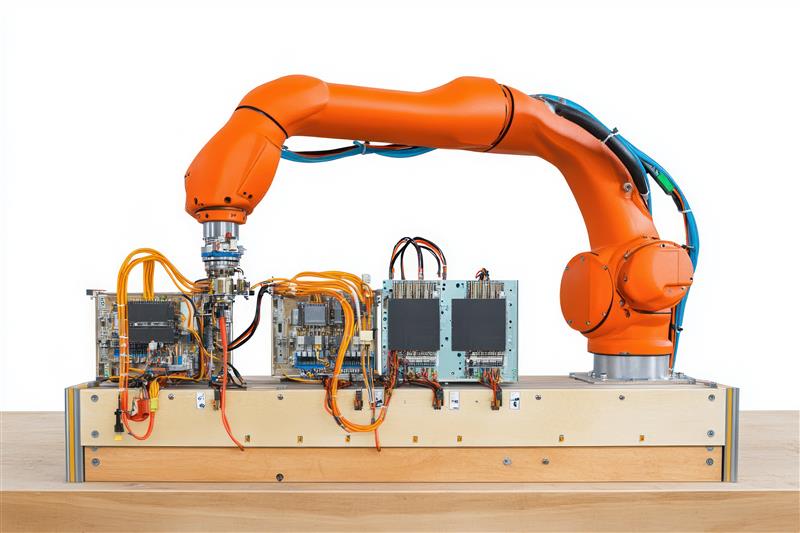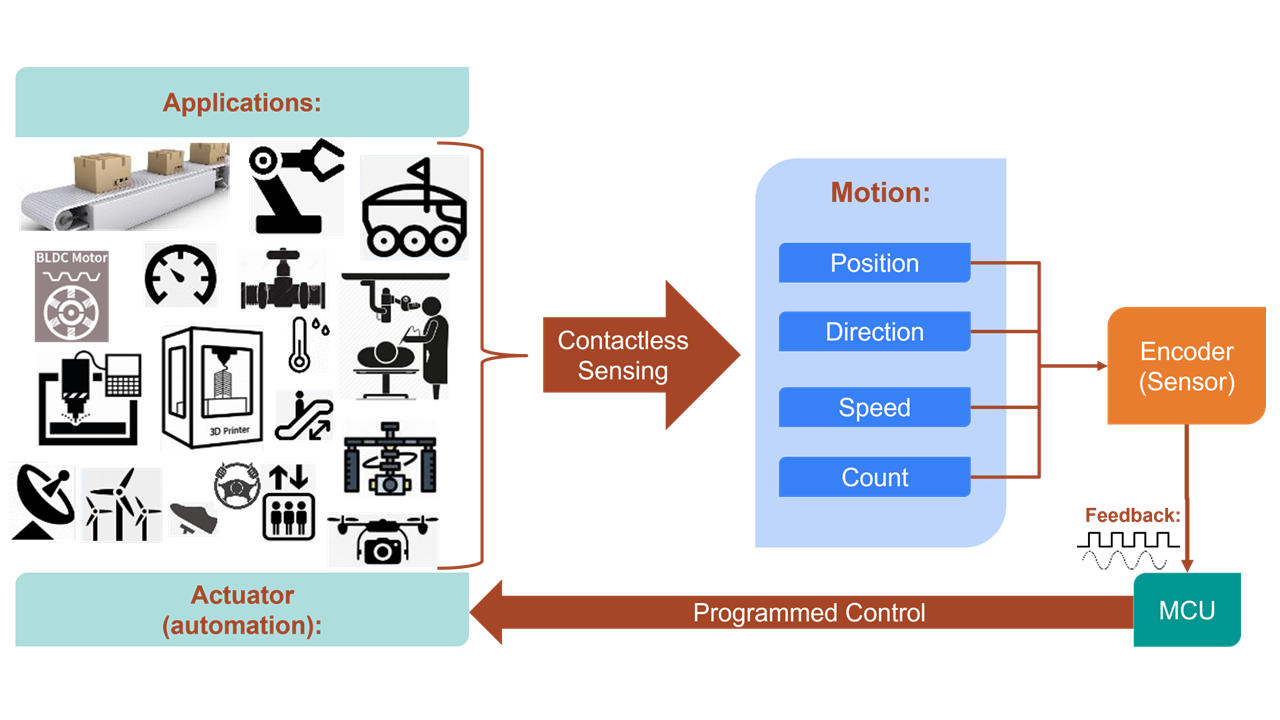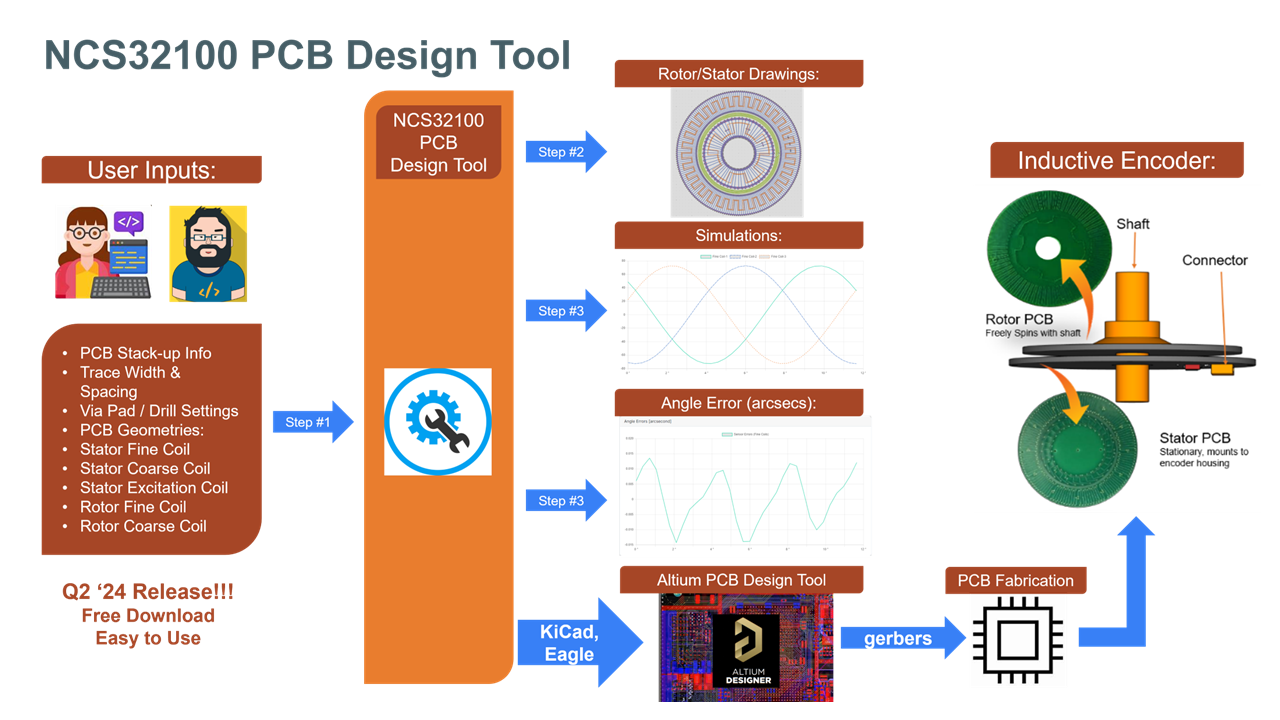Electric Motor Drive Systems (EMDS) rely heavily on position encoders to enhance efficiencies and comply with increasingly demanding regulations. As shown in Figure 1, these devices, which can be mechanical, optical, magnetic, or inductive, enable high-precision motor control and synchronization by feeding back speed and position sensing information to the controller.
Notably, rotary inductive encoders stand out in hostile environments due to their immunity to contaminants such as dirt, magnetic swarf, moisture, and shock. These devices, which are based on Faraday’s principle of mutual electromagnetic induction, are widely used throughout industry 4.0, measuring the positional movement of gearboxes, pedals, mechanical arms, and many other industrial systems.
Rotary Inductive Sensor Principles
A typical rotary inductive encoder has three main components, as shown in Figure 2. A rotor is attached to the spinning motor shaft and a stator is mounted on the encoder housing. The rotor and stator each contain sets of flat coils that are manufactured onto PCBs, and a position sensing device, such as the onsemi NCS32100 inductive position sensor, is normally attached to the stator.
The sensing device transmits a sine wave (4 MHz with the NCS32100) into an excitation coil on the stator, which acts like an antenna and couples energy into the rotor’s receiving coils. The stator also has a set of receiving coils, and when the rotor spins, the coupled energy in its coils disturbs these stator receiving coils. The stator receiving coils are connected to receive inputs on the sensing device, which measures the rotor position by processing the disturbances in the stator receiving coils.
The resolution and accuracy of rotary inductive encoders are improved by increasing the numbers and varying the patterns of the rotor and stator coils, and increasing the number of received inputs on the sensing device.
Introducing the onsemi NCS32100
The NCS32100 is a newly patented, dual inductive sensor that is ideally suited for industrial market including robotics, motor control and positioning, and servo applications.
The NCS32100 supports static high-speed applications, giving accuracy of 50 arcseconds or better at speeds up to 6,000 rpm, and functional rotor speed of up to 45,000 rpm.
The fully featured controller and sensor interface offers high resolution, high accuracy angular sensing when paired with a contactless PCB sensor. The device has a highly configurable 8-channel sensor interface, supporting connections to a wide variety of inductive sensor patterns and offers a wide range of digital output formats. Velocity, temperature and battery backup measurements are also provided, and integrated power supply circuitry supports a wide VCC range and battery backup capability.
Web-Based Design Tool from onsemi
The overall resolution and accuracy of a rotary inductive encoder is dependent upon the design of the stator and rotor PCBs as well as the performance of the sensing device. PCB design is challenging, with tight tolerances required in parameters such as trace width and spacing, via pad diameter, drill diameter, and the thickness of copper and insulation layers.
Since incorrect designs can dramatically impact the performance of the encoder, onsemi has created the web-based NCS32100 PCB design tool which guides the engineer through the necessary PCB design steps. Users of the tool follow a three-step process, figure 3 - inputting a defined set of data describing the encoder design, generating detailed drawings for the rotor and stator PCBs, and running simulations based on the input design parameters. These user-run simulations model receiver input amplitudes and angle errors (arcsecs) against the input parameters, and, by iterating through these parameters, the solution can be optimized for the required cost and accuracy.
Let onsemi help accelerate the time to revenue
Rotary inductive encoders are a popular choice for motor control solutions in hostile industrial environments where robustness and immunity to contaminants is critical. While the NCS32100 sensor from onsemi offers the designer a highly accurate and configurable solution, the overall encoder performance in any system can be compromised by poor PCB design. The NCS32100 PCB Design Tool enables the designer to confidently optimize PCB design without committing resources to prototypes. By iterating through a range of input options, the PCB coil design tool enables the designer to quickly optimize PCB design based on required cost and accuracy, thereby accelerating development cycles and reducing time to revenue.
Industrial system manufacturers can have confidence in the accuracy of their designs based on the NCS32100 since, in tests run by onsemi, the device produced accuracy levels comparable to the precision Gurley encoder, which is considered an industry reference.
To find out more about the NCS32100 from onsemi and available design tools, you can view the full free webinar here: Improving Accuracy with Inductive Position Sensor PCB Design Tools



